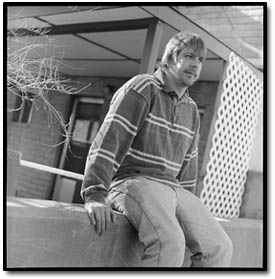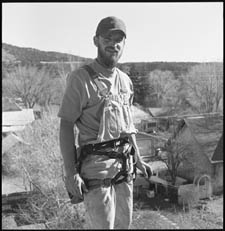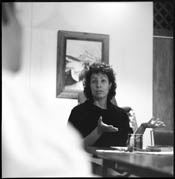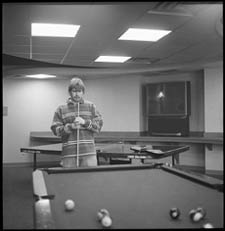|
Hilltop House helps offenders transition back
into the community
story and photos by Ole Bye
 |
Mike Uhland sits in front of
his new apartment. He just moved out of Hilltop’s residential
program. “It’s
weird for me, just because I’ve never been sober,”
Uhland says. “I’m just trying to adjust to living
a more
socially acceptable lifestyle, I guess. It’s kind of
scary.”/Photo by Ole Bye. |
From its elevated position just west of the Animas River, Hilltop
House affords a perfect view of the city of Durango. It is into
this community that about 40 Hilltop clients bike or walk daily.
They go to jobs, to therapy, sometimes to coffee shops or to laundromats.
On the street, it is far from obvious that they are convicts working
their way out of the correctional system, people trying to regain
a place in society.
As a part of the Colorado Division of Criminal Justice, Hilltop
House plays the important role of halfway house, providing a buffer
between prison and the street. Hilltop Director John Schmier elaborates,
saying, "Community corrections was started to help offenders
transition back into the community by building a savings account
and helping them pay their restitution, court costs, fines but
also to provide them with a place where they can continue their
treatment."
According to Schmier, the Hilltop program is effective. "I
would say were in the mid-80th percentile of successful completions",
he says.
A number of clients agree, noting that the program helped them
get back on their feet and stay straight. "I hate to say
it, but, yeah, it has (helped)", says client Mike Uhland."Its
hard, but it's not as hard as the life I was living before".
But the road to re-assimilation is a long one, and former convicts
often encounter frustration, mistrust and alienation.
 |
Hilltop resident Jed Bailey pauses during
his work as a roofer in Durango. “If it
did happen to come up in the future,” he says of his
time at Hilltop, “(I) hope that
things would be looked at through perceptive eyes.”/Photo
by Ole Bye. |
A look inside Hilltop House
The Hilltop program began in the early 1980s, and in the early
years, it shuffled locations between several downtown houses.
Funding was sporadic, says Schmier. "The budget was so small
that when they ran out of money, the facility would just close".
By 1985, funding had solidified, and the program built its own
facility on Avenida del Sol.
Direct-sentence offenders (who avoid prison by being sentenced
directly to Hilltop by a judge) as well as inmates from local
prisons always have been part of the program. In 1997, Hilltop
also began accepting inmates from the Colorado State Department
of Corrections and the Federal Bureau of Prisons. Funding for
Hilltop comes from all of these sources; the money follows the
offenders.
Clients of Hilltop participate in a tightly structured program
meant to reintroduce them to everyday life. To participate in
the program, clients must work full time but may substitute hours
with school. Merit is earned in a classification system, and clients
work toward nonresidential status, and eventually, release.
Schedules are precisely regimented, and clients must get passes
to leave the facility for purposes other than work or treatment.
Hilltop employees must be able to reach a given client within
two hours or the client is placed on escaped status. Breathalyzer
tests are a part of daily life at Hilltop, and residential clients
must be in-house for a minimum of eight hours a day.
"I pretty much supervise their whole life for the time
they're with us", says Case Manager Nick Beveridge.
When an individual enters the program, he or she is given 10
business days to find employment. "Usually, we have so many
people calling us looking for people to work, that we have a two-week
limit", says Schmier. "If you can't find a job in 10
days, we have to start wondering if you're employable...In the
nine years I've been here, I've seen one client go back to prison
because he couldn't find a job."
It's not difficult for Hilltop clients to find at least some
kind of work, in part because employers know what to expect. "One
thing employers like about us is the clients will show up, theyre
going to show up sober, and they're going to show up with their
lunch", Schmier says. Some employers are wary of liaison
with Hilltop, though, because of procedural requirements imposed
by the state, as well as conflicts with the tight schedules imposed
by Hilltop.
 |
| Counselor Peg Christian leads
a discussion during the victim awareness class she teaches
at Hilltop./Photo by Ole Bye |
The day to day
By outward appearances, the life of a Hilltop client looks pretty
ordinary. The difference is that personal choice has been eliminated.
Client Jed Bailey comments, "A lot of times I may have called
in and said, 'Hey, I'm just not coming in today'. But at Hilltop
you cant do that. No matter what, you gotta go to work."
Although clients must work at least 35 hours a week, most work
more. Mike Uhland substitutes some of his work hours with classes
at Pueblo Community Colleges Durango extension. Having just moved
out of Hilltop House to his own apartment, he worries about making
ends meet: "I'm going to have to get a second job to swing
it", he says. "Thirty hours a week isnt going to cut
it."
Living expenses can be high, but a second primary financial
obligation of Hilltop clients is paying off their restitution.
"That's the biggest thing that is on my plate," says
client Serenity Leonard.
When they're not at work, clients can, depending on their status,
get social passes, allowing them to spend time doing other things,
like going to the coffee shop or the rec center. Where clients
can go is limited by the need to contact them within two hours.
"One of the main things that bothers me is you can't really
go hiking, you can't go fishing, you can't do anything where there
isn't a phone that they can get a hold of you," Uhland says.
 |
| Mike Uhland shoots pool at the
Durango Rec Center. The center is the only venue in town where
Hilltop clients can shoot pool because it is alcoholfree. |
Challenges
Adapting to the regimen of the Hilltop program is the first
challenge for clients; the next is confronting the stigma of being
a convict. "It was hard at first," Leonard says. "I
kept my head down. I didnt really go out and do things. But that
went away", she says, "as full-time work forced me to
be back in the public eye." Occasionally, some clients run
into employers who shy away from hiring them based on their past.
Bailey advises, "You have to look past a lot of what other
people think and feel, and build some sort of level of trust with
the community again." Although, he says for the most part,
Durango has been receptive and helpful.
On top of everything else, Leonard experienced difficulty as
one of only four women living in-residence at Hilltop House. "A
lot of the guys were just coming directly out of prison",
she says. "It was really hard. There were a lot of incidents
where the guys would make comments to me". Now that she's
in the nonresidential program, with an apartment of her own, Leonard
feels a different kind of pressure. "I have my freedom, but
I don't", she says."I dont live (at Hilltop), but I
have to follow their rules. I still have to call, and I still
have to let them know what I'm doing, and I still have a curfew."
Leonard, Uhland and Bailey are all natives of Durango and have
the advantage of knowing the turf. Clients who offended here but
are not natives often times have no connections in the community.
Peg Christian, who leads a victim awareness class at Hilltop,
points out, "These folks are really isolated from the community.
They go and work, but they dont know too many people. Re-assimilation
could be enhanced", she says, "by getting people together
in informal settings so they feel more connected the community."
"Because that's where you prevent crime, is when people
are connected because they dont want to hurt people they care
for."
The paramount challenge inherent in the Hilltop program is the
underlying foundation of strict personal responsibility. Self-restraint
is important, says Uhland, and when discipline gets frustrating,
the key is "just kind of biting your tongue." Uhland,
who has been out on probation before, says he has a hard time
leaving the structure of the Hilltop program: "I did all
right for a while, but then I got bored. I wasn't busy. I started
hanging out where I used to, and it was only a matter of time
before I was just as bad off as I ever was."
Many in the program have a hard time accepting its authority.
"They kind of treat you like a little kid, but then I try
to look at it like I've only demonstrated me being a little kid
to them, so how else would they treat me?" Uhland says. "It
is hard to always own up to that, you know."
The future
One thing that seems to be on the minds of Hilltop clients is
what they'll do when they finish the program. Some will stay in
the community. Jed Bailey is thinking about starting his own business.
"This will always be my home", he says, noting that
 |
Serenity Leonard. Of the Hilltop program,
she says, “You either sink or you
swim. I chose to swim.” |
first, he is going to take a long camping trip. Mike Uhland doesn't
think he can be a part of Durango anymore, saying, "I kind
of feel like that's a cop out, that if I'm going to be sober,
I should be able to do it here, as well. But I can't help but
think it's going to be easier elsewhere." He adds, "Ultimately,
Id like to be a Ducati mechanic."
Serenity Leonard isn't sure if she'll still call Durango home,
but in the meantime, she has become involved in the La Plata Youth
program and visits classrooms to tell about her experiences in
the correctional system. "It's really rewarding", she
says, "we give back to the kids, and try to teach them through
our mistakes."
When asked about the effectiveness of the program, these clients
agree that you get out of it what you put in. "You either
sink or you swim. I chose to swim", Leonard says.
Bailey is pragmatic in his attitude, saying, "I messed
up, and I gotta do what I gotta do."
This feeling of accomplishment is equally important for Hilltop
employees, says case manager Kurt Wood. "When you have somebody
who is really open to the change in their life and you walk hand-in-hand
with them through the program, and you support their growth, and
you see them leave through the front door without handcuffs on,
its a really good feeling", he says. "Thats what kind
of recharges my batteries to continue to do this."
Still with three years to go in the Hilltop program, Leonard
is looking forward to the future. "I'm such a different person
than the person I used to be, so I'm ready to make changes in
my life."
|

